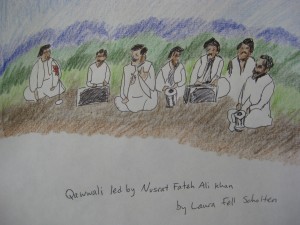WEEK 8 : The Dhikr: Music and Dance in the Sufi Tradition
Dhikr means “remembering” and is a Sufi devotional practice that varies from region to region across the Muslim world. In “Sufi Music and Dance” from The Shambhala Guide to Sufism (1997), Carl Ernst writes that “whirling dervishes” and the modern qawwali ritual are contemporary manifestations of earlier Sufi traditions (180). The following themes came up in my study of music and dance in the Sufi Tradition, and I incorporated them into my drawing of Nusrat Fateh Ali Khan singing a qawwali, which is a kind of dhikr.
In “Sufi Music and Dance,” Carl Ernst writes that the critical issue in this musical performance is the sensitivity of the listener (181). Sama‘ means “listening”. Ernst writes, “the source of sama‘ is…the rapture or attraction (jadhb) of God, a kind of energy that irresistably draws one towards him” (185), and, “the effect of sama‘…is ecstasy (wajd)” (182). In my opinion, the rhythmic beat of the qawwali does indeed create opportunity for ecstasy and spiritual transcendence, regardless of the religion of the listener.
Secondly, in class and in discussion group we talked about the issue of whether or not secular audiences understand Sufi music the way it is intended to be understood in Islamic contexts. Ernst writes that secular concerts of this spiritual music are growing in popularity, and the context in which the music and dance is experienced increasingly includes people who may not understand the words or share the Muslim religion. (191) I would fall into this latter category myself. Personally, I suspect that my understanding of dhikr is limited by my inability to understand the language more than it is by my religion.
Finally, in “The Sacred Music of Islam: Sama‘ in the Persian Sufi Tradition” Leonard Lewisohn writes, “Geographical features, mountains for instance, are here no longer merely physical features; they have a significance for the soul; they are psycho-cosmic aspects.” (14) I wonder what happens to music containing geographic meaning specific to the landscape for which it was composed, when the music is played on a different continent with a distinctly different landscape and geographical features. Perhaps it evokes images or feelings of the landscape in which it originated? Here I tried to evoke the feeling of the Punjab province of northern Pakistan where Nusrat and his Qawwali are from, which is mostly flat rich agricultural land but has some steep hills.